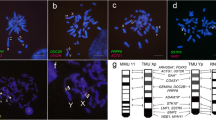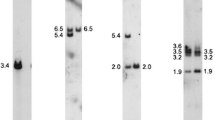Abstract
The Okinawa spiny rat, Tokudaia muenninki, is the only species with a Y chromosome in the genus Tokudaia. Its phylogenic relationship with two XO/XO species, Tokudaia osimensis and Tokudaia tokunoshimensis, lacking a Y chromosome and the mammalian sex-determining gene SRY, is unknown. Furthermore, there has been little cytogenetic analysis of the sex chromosomes in T. muenninki. Therefore, we constructed molecular phylogenetic trees with nucleotide sequences of cyt b, RAG1, and IRBP. All trees strongly supported that T. muenninki was the first to diverge from the Tokudaia ancestor, indicating that loss of the Y chromosome and SRY occurred in the common ancestor of the two XO/XO species after T. muenninki diverged. We found that the X and Y chromosomes of T. muenninki consisted of large euchromatic and heterochromatic regions by conducting G- and C-banding analyses. PCR, Southern blotting, and FISH revealed that T. muenninki males had multiple SRY copies on the long arm of the Y chromosome. At least three of 24 SRY sequences contained a complete open reading frame (ORF). A species-specific substitution from alanine to serine was found in all copies at the DNA-binding surface within the HMG-box, suggesting that it occurred in an original SRY.






Similar content being viewed by others
Abbreviations
- BSG:
-
Barium hydroxide/saline/Giemsa
- DSD:
-
Disorders of sexual development
- FISH:
-
Fluorescence in situ hybridization
- GTG:
-
G-banding by Trypsin using Giemsa
- HMG:
-
High-mobility group
- IHB:
-
Intercalary heterochromatin block
- L1:
-
Long interspersed nucleotide element 1
- LTR:
-
Long terminal repeat
- ML:
-
Maximum-likelihood
- MP:
-
Maximum-parsimony
- MYA:
-
Million years ago
- NJ:
-
Neighbor-joining
- ORF:
-
Open reading frame
- SDS:
-
Sodium dodecyl sulfate
- SSC:
-
Saline sodium citrate
- TES:
-
Testis-specific enhancer of Sox9
- UTR:
-
Untranslated region
References
Arakawa Y, Nishida-Umehara C, Matsuda Y, Sutou S, Suzuki H (2002) X-chromosomal localization of mammalian Y-linked genes in two XO species of the Ryukyu spiny rat. Cytogenet Genome Res 99:303–309
Bergstrom D, Young M, Albrecht K, Eicher E (2000) Related function of mouse SOX3, SOX9, and SRY HMG domains assayed by male sex determination. Genesis 28:111–124
Bianchi NO, Bianchi MS, Bailliet G, de la Chapelle A (1993) Characterization and sequencing of the sex determining region Y gene (Sry) in Akodon (Cricetidae) species with sex reversed females. Chromosoma 102:389–395
Bullejos M, Sánchez A, Burgos M, Hera C, Jiménez R, Diaz de la Guardia R (1997) Multiple, polymorphic copies of SRY in both males and females of the vole Microtus cabrerae. Cytogenet Cell Genet 79:167–171
Bullejos M, Sánchez A, Burgos M, Jiménez R, Diaz de la Guardia R (1999) Multiple mono- and polymorphic Y-linked copies of the SRY HMG-box in Microtidae. Cytogenet Cell Genet 86:46–50
Deuve JL, Bennett NC, O'Brien PCM et al (2006) Complex evolution of X and Y autosomal translocations in the giant mole-rat, Cryptomys mechowi (Bathyergidae). Chromosome Res 14:681–691
Dobigny G, Ozouf-Costaz C, Bonillo C, Volobouev V (2004) Viability of X-autosome translocations in mammals: an epigenomic hypothesis from a rodent case-study. Chromosoma 113:34–41
Endo H, Tsuchiya K (2006) A new species of Ryukyu spiny rat, Tokudaia (Muridae: Rodentia), from Tokunoshima Island, Kagoshima Prefecture, Japan. Mamm study 31:47–57
Graves JAM (1995) The origin and function of the mammalian Y chromosome and Y-borne genes—an evolving understanding. BioEssays 17:311–320
Honda T, Suzuki H, Itoh M (1977) An unusual sex chromosome constitution found in the Amami spinous country-rat, Tokudaia osimensis osimensis. Jpn J Genet 52:247–249
Honda T, Suzuki H, Itoh M, Hayashi K (1978) Karyotypical differences of the Amami spinous country-rats, Tokudaia osimensis osimensis obtained from two neighbouring islands. Jpn J Genet 53:297–299
Kamachi Y, Uchikawa M, Kondoh H (2000) Pairing SOX off: with partners in the regulation of embryonic development. Trends Genet 16:182–187
Kobayashi T, Yamada F, Hashimoto T et al (2007) Exceptional minute sex-specific region in the X0 mammal, Ryukyu spiny rat. Chromosome Res 15:175–187
Kobayashi T, Yamada F, Hashimoto T et al (2008) Centromere repositioning in the X chromosome of XO/XO mammals, Ryukyu spiny rat. Chromosome Res 16:587–593
Lundrigan BL, Tucker PK (1997) Evidence for multiple functional copies of the male sex-determining locus, Sry, in African murine rodents. J Mol Evol 45:60–65
Marchal JA, Acosta MJ, Bullejos M, Diaz de la Guardia R, Sánchez A (2008) Origin and spread of the SRY gene on the X and Y chromosomes of the rodent Microtus cabrerae: role of L1 elements. Genomics 91:142–151
Matsuda Y, Chapman VM (1995) Application of fluorescence in situ hybridization in genome analysis of the mouse. Electrophoresis 16:261–272
Matsuda Y, Harada Y-N, Natsuume-Sakai S et al (1992) Location of the mouse complement factor H gene (cfh) by FISH analysis and replication R-banding. Cytogenet Cell Genet 61:282–285
Michaux JR, Chevret P, Filippucci MG, Macholan M (2002) Phylogeny of the genus Apodemus with a special emphasis on the subgenus Sylvaemus using the nuclear IRBP gene and two mitochondrial markers: cytochrome b and 12 S rRNA. Mol Phylogenet Evol 23:123–136
Murphy EC, Zhurkin VB, Louis JM, Cornilescu G, Clore GM (2001) Structural basis for SRY-dependent 46-X, Y sex reversal: modulation of DNA bending by a naturally occurring point mutation. J Mol Biol 312:481–499
Nagamine CM (1994) The testis-determining gene, SRY, exists in multiple copies in Old World rodents. Genet Res 64:151–159
Phillips NB, Nikolskaya T, Jancso-Radek A et al (2004) Sry-Directed Sex Reversal in Transgenic Mice Is Robust with Respect to Enhanced DNA Bending: Comparison of Human and Murine HMG-boxes. Biochemistry 43:7066–7081
Polanco JC, Wilhelm D, Davidson TL, Knight D, Koopman P (2010) Sox10 gain-of-function causes XX sex reversal in mice: implications for human 22q-linked disorders of sex development. Hum Mol Genet 19:506–516
Posada D, Crandall KA (1998) Modeltest: testing the model of DNA substitution. Bioinformatics 14:817–818
Rowe KC, Reno ML, Richmond DM, Adkins RM, Steppan SJ (2008) Pliocene colonization and adaptive radiations in Australia and New Guinea (Sahul): Multilocus systematics of the old endemic rodents (Muroidea: Murinae). Mol Phylogenet Evol 47:84–101
Sambrook J, Russell D (2001) Molecular cloning: a laboratory manual, 3rd edn. Cold Spring Harbor Laboratory Press, New York
Sato JJ, Suzuki H (2004) Phylogenetic relationships and divergence times of the genus Tokudaia within Murinae (Muridae; Rodentia) inferred from the nucleotide sequences encoding the Cytb gene, RAG1, and IRBP. Can J Zool 82:1343–1351
Sato JJ, Hosoda T, Wolsan M, Suzuki H (2004) Molecular Phylogeny of Arctoids (Mammalia: Carnivora) with Emphasis on Phylogenetic and Taxonomic Positions of the Ferret-badgers and Skunks. Zool Sci 21:111–118
Seabright M (1971) A rapid banding technique for human chromosomes. Lancet 2:971–972
Sekido R, Lovell-Badge R (2008) Sex determination involves synergistic action of SRY and SF1 on a specific Sox9 enhancer. Nature 453:930–934
Soullier S, Hanni C, Catzeflis F, Berta P, Laudet V (1998) Male sex determination in the spiny rat Tokudaia osimensis (Rodentia: Muridae) is not Sry dependent. Mamm Genome 9:590–592
Sumner AT (1972) A simple technique for demonstrating centromeric heterochromatin. Exp Cell Res 75:304–306
Sutou S, Mitsui Y, Tsuchiya K (2001) Sex determination without the Y chromosome in two Japanese rodents Tokudaia osimensis osimensis and Tokudaia osimensis spp. Mamm Genome 12:17–21
Suzuki H, Iwasa MA, Ishii N, Nagaoka H, Tsuchiya K (1999) The genetic status of two insular populations of the endemic spiny rat Tokudaia osimensis (Rodentia, Muridae) of the Ryukyu Islands, Japan. Mamm Study 24:43–50
Suzuki H, Tsuchiya K, Takezaki N (2000) A molecular phylogenetic framework for the Ryukyu endemic rodents Tokudaia osimensis and Diplothrix legata. Mol Phylogenet Evol 15:15–24
Suzuki H, Sato JJ, Tsuchiya K et al (2003) Molecular phylogeny of wood mice (Apodemus, Muridae) in East Asia. Biol J Linn Soc 80:469–481
Swofford DL (2001) PAUP*: Phylogenetic analysis using parsimony (*and other methods). Version 4.0 beta version. Sinauer Associates, Sunderland, Mass
Tsuchiya K, Wakana S, Suzuki H, Hattori S, Hayashi Y (1989) Taxonomic study of Tokudaia (Rodentia: Muridae): I. Genetic differentiation. Memoirs Nat Sci Museum, Tokyo 22:227–234
Turner ME, Martin C, Martins AS et al (2007) Genomic and expression analysis of multiple Sry loci from a single Rattus norvegicus Y chromosome. BMC Genet 8:11
Waters PD, Wallis MC, Graves JAM (2007) Mammalian sex–Origin and evolution of the Y chromosome and SRY. Semin Cell Dev Biol 18:389–400
Werner MH, Huth JR, Gronenborn AM, Clore GM (1995) Molecular basis of human 46X, Y sex reversal revealed from the three-dimensional solution structure of the human SRY-DNA complex. Cell 81:705–714
Wilhelm D, Palmer S, Koopman P (2007) Sex determination and gonadal development in mammals. Physiol Rev 87:1–28
Acknowledgements
The authors thank C. Nishida-Umehara and K. Matsubara for help with cell culturing and chromosome banding and Y. Miyake, N. Kotaka, and S. Abe for their efforts in capturing the animals. This work was supported by a Grant-in-aid for Scientific Research (No. 16086201) from the Ministry of Education, Culture, Sports, Science and Technology, Japan, the Global Environment Research Fund F-3 (for FY) from the Ministry of the Environment, Japan, a grant from the Sumitomo foundation, Japan, and a grant from Hokkaido University, Japan.
Author information
Authors and Affiliations
Corresponding author
Additional information
Responsible Editor: Fengtang Yang.
Electronic supplementary materials
Below is the link to the electronic supplementary material.
Supplementary Figure S1
Alignment of 24 different sequences containing the full-length ORF of SRY with partial 5' UTR and 3' UTR of T. muenninki. Identical residues are indicated by dots (.). The start codons and the stop codons are colored dark gray and light gray, respectively. The HMG-box is underlined. The sites of insertion/deletion are indicated by (-). (PDF 80 kb)
Rights and permissions
About this article
Cite this article
Murata, C., Yamada, F., Kawauchi, N. et al. Multiple copies of SRY on the large Y chromosome of the Okinawa spiny rat, Tokudaia muenninki . Chromosome Res 18, 623–634 (2010). https://doi.org/10.1007/s10577-010-9142-y
Received:
Revised:
Accepted:
Published:
Issue Date:
DOI: https://doi.org/10.1007/s10577-010-9142-y




